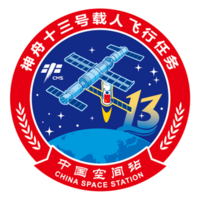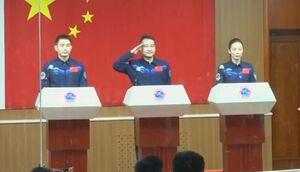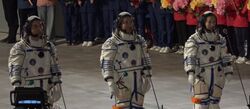Shenzhou 13
Topic: Astronomy
 From HandWiki - Reading time: 5 min
From HandWiki - Reading time: 5 min
 Launch of Shenzhou 13 on a Long March 2F | |
| Mission type | Tiangong space station crew transport |
|---|---|
| Operator | China Manned Space Agency |
| COSPAR ID | 2021-092A |
| Mission duration | 182 days, 9 hours and 32 minutes |
| Spacecraft properties | |
| Spacecraft type | Shenzhou |
| Manufacturer | China Aerospace Science and Technology Corporation |
| Crew | |
| Crew size | 3 |
| Members | Zhai Zhigang Wang Yaping Ye Guangfu |
| EVAs | 2 |
| EVA duration | 12 hours 36 minutes[1] |
| Start of mission | |
| Launch date | 15 October 2021, 16:23:56 UTC[2] |
| Rocket | Long March 2F |
| Launch site | Jiuquan, LA-4/SLS |
| Contractor | China Academy of Launch Vehicle Technology |
| End of mission | |
| Landing date | 16 April 2022, 01:56:49 UTC |
| Landing site | Inner Mongolia, China |
| Orbital parameters | |
| Reference system | Geocentric orbit |
| Regime | Low Earth orbit |
| Inclination | 41.5° |
| Docking with Tiangong space station | |
| Docking port | Tianhe nadir |
| Docking date | 15 October 2021, 22:56 UTC |
| Undocking date | 15 April 2022, 16:44 UTC |
| Time docked | 181 days, 17 hours and 48 minutes |
 Shenzhou 13 mission patch  Ye Guangfu, Zhai Zhigang and Wang Yaping Shenzhou programme | |
Shenzhou 13 (Chinese: 神舟十三号; pinyin: Shénzhōu Shísān-hào; literally: 'Divine Boat Number 13') was a Chinese spaceflight to the Tiangong space station, launched on 15 October 2021. It carried three People's Liberation Army Astronaut Corps (PLAAC) taikonauts on board a Shenzhou spacecraft. The mission was the eighth crewed Chinese spaceflight and the thirteenth flight overall of the Shenzhou program.
Background
Shenzhou 13 was the second spaceflight to the Tiangong space station (at the time consisting only of the Tianhe core module), and the first with a planned duration of six months (180 days).[3] Following Shenzhou 13, six months would become the standard orbital duration for subsequent Shenzhou missions.[4]
For Shenzhou 13, the China Academy of Space Technology developed a new method of radial docking of the spacecraft to the bottom of Tiangong's Tianhe core module, differing from the front and rear docking method used previously by Shenzhou 12 and the Tianzhou cargo missions. This new method of docking would be crucial for both cargo logistics and crew operations, and would allow multiple Shenzhou spacecraft to dock to Tiangong at one time, making in-space crew changeovers possible for the first time.[5]
The crew of Shenzhou 13 was announced on 14 October 2021.[6]
Mission
The flight launched from Jiuquan Satellite Launch Center on 15 October 2021 at 16:23 UTC, following the launch of the Tianzhou 3 cargo spacecraft.[7][8] Just over 6.5 hours after launch, the spacecraft docked with the Tianhe core module's nadir docking port.[9] The crew entered the station on 16 October at 01:58 UTC.[10]
During the mission, the Shenzhou 14 spacecraft remained on standby to serve as an emergency rescue vehicle.[11]
The Shenzhou 13 crew carried out two spacewalks, worked on payloads both inside and outside the station, and carried out other scientific work during the six-month mission.
Spacewalks
On 7 November 2021, the first scheduled spacewalk of Shenzhou 13 was carried out by Zhai Zhigang and Wang Yaping, during which Wang Yaping became the first Chinese woman to perform a spacewalk.[12] The two taikonauts installed a dual-arm connector for the station's robotic arm, and tested EVA equipment on the exterior of Tianhe. The spacewalk lasted for 6 hours and 25 minutes.[13]
On 26 December 2021, the second and final spacewalk of the mission was carried out by Zhai Zhigang and Ye Guangfu, with Wang Yaping assisting the pair from inside the Tianhe core module. The taikonauts deployed panoramic camera C, installed a foot restraint platform, and tested various methods of moving objects outside the station. The spacewalk lasted for 6 hours and 11 minutes.[14]
Space lectures
On 9 December 2021 at 3:55 PM China Standard Time (07:55 UTC), the crew of Shenzhou 13 conducted their first live "space lecture" broadcast. The "main classroom" was located in the China Science and Technology Museum in Beijing, with "branch classrooms" in Nanning, Wenchuan, Hong Kong, and Macau. During the lecture, part of which was led by Wang Yaping, the taikonauts explained what living in space was like, and performed scientific experiments on cell biology, the behavior of effervescent tablets in microgravity, and water surface tension. After the lesson, the taikonauts were given time to answer schoolchildren's questions from the classrooms.[15][16]
On 23 March 2022 at 3:40 PM China Standard Time (07:40 UTC), the crew of Shenzhou 13 conducted a second live "space lecture" broadcast. The "main classroom" was once again in the China Science and Technology Museum in Beijing, with "branch classrooms" in Lhasa, Tibet; and Ürümqi, Xinjiang. The lecture followed a similar structure to the previous broadcast, with a science lesson followed by a question-and-anwer session with the taikonauts.[17]
Interaction with American students
On 10 April 2022, at 3:00 AM China Standard Time (9 April, 19:00 UTC), a special question-and-answer session between the crew of Shenzhou 13 and American students was held at the Chinese Embassy in the U.S. in Washington, D.C., hosted by Chinese Ambassador to the U.S. Qin Gang. During the event, a pre-recorded message from SpaceX CEO Elon Musk was also played, expressing his wishes for further international cooperation in space in the future.[18]
Return
Shenzhou 13 undocked from Tiangong on 15 April 2022 at 16:44 UTC, and landed nine hours later on 16 April at the Dongfeng landing site in the Gobi Desert in Inner Mongolia at 01:56 UTC.[19][2][20]
Crew
| Position | Crew member | |
|---|---|---|
| Commander | Second spaceflight | |
| Operator | Second spaceflight | |
| System Operator | First spaceflight | |
Zhai Zhigang previously flew on Shenzhou 7.
Wang Yaping, the first woman to visit the Tiangong space station and the first Chinese woman to fly to space twice, previously flew on Shenzhou 10.[6]
See also
- Shenzhou (spacecraft)
- Tiangong space station
- Tianzhou (spacecraft)
- List of Tiangong space station spacewalks
References
- ↑ "Tiangong: Expedition 2". 2021-12-27. http://www.spacefacts.de/tiangong/english/crew_2.htm.
- ↑ 2.0 2.1 "神舟十三号定于周六0时23分发射 新"太空出差三人组"包括一位女航天员". 7 August 2023. https://cn.reuters.com/article/instant-article/idCNKBS2H40N0.
- ↑ "中国航天进入空间站建造关键时期——访中国载人航天工程办公室主任郝淳". http://www.xinhuanet.com/2021-04/29/c_1127393519.htm.
- ↑ "空间站建造后续有四次载人飞行,航天员每次在轨驻留3至6个月". https://www.thepaper.cn/newsDetail_forward_12457158.
- ↑ "China's Shenzhou 13 Mission and Its Long-Term Impact". The Diplomat. https://thediplomat.com/2021/10/chinas-shenzhou-13-mission-and-its-long-term-impact/.
- ↑ 6.0 6.1 "China unveils Shenzhou-13 crew for six-month space station mission". http://www.ecns.cn/news/sci-tech/2021-10-14/detail-iharvwpk8244746.shtml.
- ↑ "China launches Shenzhou 13 astronauts on historic mission to new space station". space.com. 15 October 2021. https://www.space.com/china-launches-shenzhou-13-astronauts-to-space-station.
- ↑ Andrew Jones (September 20, 2021). "Tianzhou-3 spacecraft docks with Chinese space station". Space News. https://spacenews.com/tianzhou-3-spacecraft-docks-with-chinese-space-station/.
- ↑ "China's Shenzhou-13 spacecraft docks for 6-month mission". October 15, 2021. https://apnews.com/article/space-launches-space-exploration-technology-science-china-151a01e585e277d55a1fbbbc8db69045.
- ↑ "神舟十三号3名航天员顺利进驻天和核心舱". xinhua.news. http://www.news.cn/politics/2021-10/16/c_1127963892.htm.
- ↑ "China's Shenzhou 14 is on standby to launch in case of space station emergency". 2021-10-22. https://www.space.com/china-readies-shenzhou-14-for-space-station-emergency. Retrieved 2021-10-25.
- ↑ Navin, Joseph (2021-11-07). "Wang Yaping becomes the first Chinese woman to walk in space" (in en-US). https://www.nasaspaceflight.com/2021/11/first-chinese-woman-spacewalk/.
- ↑ "China's Shenzhou-13 taikonauts complete first extravehicular mission". Xinhua News. 7 November 2021. http://www.news.cn/english/2021-11/08/c_1310296779.htm.
- ↑ Davenport, Justin (26 December 2021). "Shenzhou-13 crew conducts second spacewalk of mission". NASASpaceFlight.com. https://www.nasaspaceflight.com/2021/12/shenzhou-13-second-spacewalk/.
- ↑ 张馨方 (2021-12-06). ""天宫课堂"第一课定于12月9日下午在中国空间站开讲,此次太空授课活动将进行全程现场直播" (in zh). https://mp.weixin.qq.com/s/gQkzsxQBJEDW7zQQTuCjPw.
- ↑ Live: Special coverage of first class from China's space station on YouTube
- ↑ Tiangong (China Space Station) is going Live 直播中国空间站视角下的地球 on YouTube
- ↑ "Elon Musk featured in Chinese embassy event focused on space exploration". South China Morning Post. 10 April 2022. https://www.scmp.com/news/china/diplomacy/article/3173723/elon-musk-featured-chinese-embassy-event-focused-space.
- ↑ @CNSpaceflight. "Jiuquan Satellite Launch Center conducted the last dress rehearsal of #Shenzhou13 recovery. According to the post in Wechat, the landing target is in the east area of Dongfeng Landing Site, same as Shenzhou-12, at ~09:10 local time on APR.16". https://twitter.com/CNSpaceflight/status/1513791327183400965. Missing or empty |date= (help)
- ↑ "Watch China's Shenzhou 13 astronauts return to Earth from space station tonight". Space.com. 15 April 2022. https://www.space.com/china-shenzhou-13-astronauts-space-station-landing-webcast.
 |
 KSF
KSF

